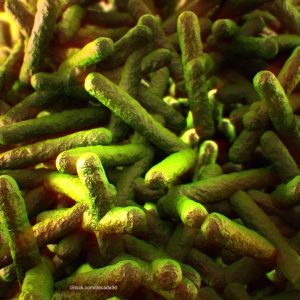The deadly Listeria monocytogenes outbreak that has killed three people in Kansas has been linked to Blue Bell ice cream. When most people think of food poisoning, they think of undercooked or raw meat or eggs. How does a supposedly innocuous product like ice cream become contaminated with pathogenic bacteria?
 Listeria monocytogenes bacteria are everywhere in our environment. These bacteria live in soil and water. Animals carry the bacteria and can transfer it to our food though feces, through dirty irrigation water, and in food harvesting and transport.
Listeria monocytogenes bacteria are everywhere in our environment. These bacteria live in soil and water. Animals carry the bacteria and can transfer it to our food though feces, through dirty irrigation water, and in food harvesting and transport.
All bacteria love food because it’s a great source of nutrients. Listeria monocytogenes bacteria are unique in that they can grow at refrigerator and even freezer temperatures. In fact, the longer a food contaminated with this bacteria is held below 40°F, the more Listeria bacteria can grow. That’s why refrigerated and frozen foods, which usually have a long shelf life, are at particular risk for this type of contamination.
Attorney Fred Pritzker, who has represented many clients who have been sickened by Listeria bacteria, said, “manufacturers, especially those who make refrigerated and frozen products, need to be especially vigilant about cleaning facilities and machines to make sure the food they produce is safe. This isn’t the first time ice cream has been contaminated with Listeria monocytogenes bacteria. It’s very unfortunate that people in the hospital to get better were infected with this bacterium.”
At this point, we do not know whether one of the ingredients used to make the ice cream was the source of the bacteria, or if human error was responsible for the contamination. If the machinery used to make the ice cream was contaminated, and not properly maintained or cleaned, Listeria bacteria can thrive for months. Ice cream is made by first making a custard of milk, sugar, and sometimes eggs, which is chilled and then frozen. Contamination is possible at several steps along this production chain, especially with complicated equipment that can be challenging to clean properly.
Investigations by public health officials have revealed that one machine at the Blue Bell Creameries facility in Brenham, Texas was contaminated with the outbreak strains of Listeria. In fact, this current outbreak lasted from January 2014 to January 2015 and there are likely more people sickened, as the machine was probably contaminated for some time.
The five patients identified so far in this outbreak were at the Via Christi hospital in Wichita, Kansas. They were served ice cream or milkshakes made from ice cream while hospitalized. If the machine used to make milkshakes was not thoroughly disinfected, other foods made in that equipment may have been contaminated too.
The symptoms of a Listeria monocytogenes infection include flu-like fever and muscle aches, upset stomach, diarrhea, stiff neck, headache, loss of balance, confusion, or convulsions. Most people get ill within three to seventy days after exposure. Those who are most at risk for serious complications include the very young, the elderly, and pregnant women, who can suffer miscarriage and stillbirth. If you ate any of the recalled Blue Bell products and have been experiencing these symptoms, see your doctor as soon as possible.




